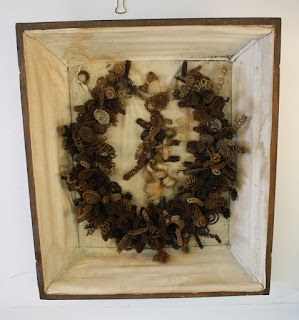This week’s featured artifact at the museum is our hair wreaths and a receiver box.
Hair art traditions date back as far as the 12th century, however, it was during the 1800s that this tradition became increasingly more popular. This popularity came about due to two events: the American Civil War and the passing of Queen Victoria’s husband Albert in 1861. During wartime, thousands of mourning families wanted a way to respectfully honor their dead, this brought about hair collecting. Queen Victoria took to wearing all black until her death and wore a piece of hair jewelry with Alberts hair to accompany every outfit. This display made public mourning a socially acceptable practice. Later, this practice became not only a sign of mourning of those passed but as a gift of affection for current loved ones as well.
 Hair of deceased as well as current loved ones would be collected in a hair receiver until enough was gathered to create an item of jewelry or a wreath. These receivers were often decorated wooden or porcelain boxes with holes in the top to collect the hair and often kept prominently on a dresser.
Hair of deceased as well as current loved ones would be collected in a hair receiver until enough was gathered to create an item of jewelry or a wreath. These receivers were often decorated wooden or porcelain boxes with holes in the top to collect the hair and often kept prominently on a dresser. Once collected, the hairs were woven around wires and bent into intricate designs often including flowers and leaves. Hairs of the most recently deceased would be placed in the middle, with the other hair pieces following around the wreath. Wooden or glass beads, ribbons and buttons were also included in the designs. Hair wreath designs are often horseshoe shaped, used for good luck, and placed upwards in order to catch luck for those represented in the wreath.
When completed, the hair wreaths would be displayed in a prominent position in the household or given to loved ones as gifts. See attached photos of one of our collections’ hair wreaths and a receiver.


No comments:
Post a Comment